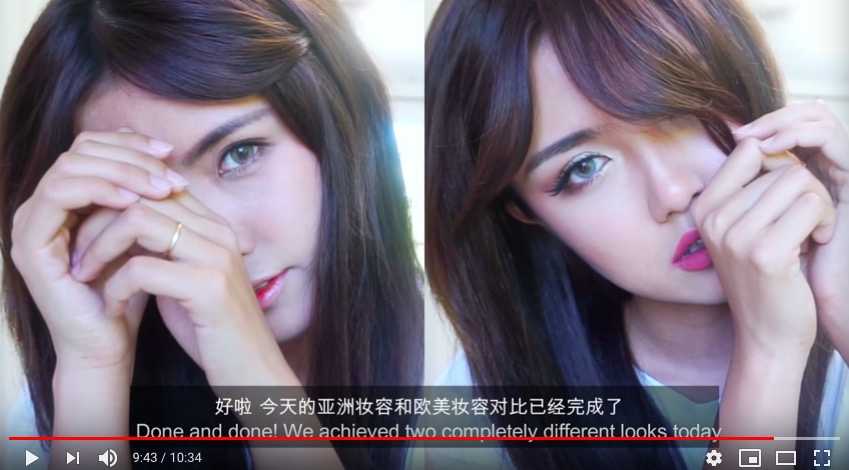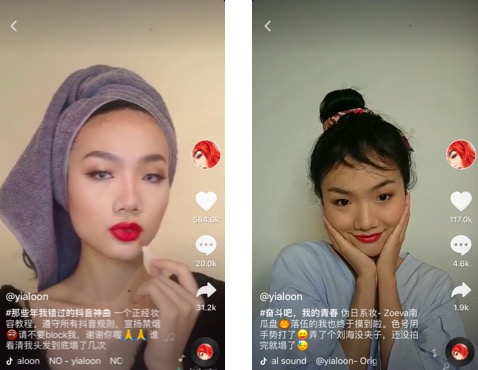
The popularity of 'exotic' make-up
Make-up, as a way to enhance or alter the appearance of the face, or fragrance and texture of the body, is gaining an increasing popularity among people all over the world both young and old, female to male. Where there is a need, there is a way. People began using make-up thousands of years ago. The well-known Egyptian Queen Cleopatra may leave you with an impression of black eyeliner and green eyeshadow, a display of how women did make-up 5000 years ago.
However, make-up trends change with the process of globalization, the reshaping of ideas on beauty, and the development of cosmetics. This article is going to discuss the heated trend of and the the reasons behind pursuing 'exotic' looks as a global phenomemon. Exotic make-up is a trend that explicitly uses cultural practices and semiotics in order to index 'other cultures'.
The current trend of exotic make-up
We live in a network society characterized by the availability of online mass media (Castells, 1996). The wide spread of such media provides people with platforms for posting make-up tutorials, which has lead to athriving ecosystem of make-up YouTubers and Beauty Vloggers. Since make-up styles from different ethnicities and regions are popular with make-up lovers all over the world, there are a lot of exotic make-up tutorials online.
A famous make-up YouTuber named Wenwen Fitzgerald compares how Asian and Western make-up look different. As she mentions in the video, Asian make-up pursues a natural look, while Western makeup emphasizes a sense of contour and health. Differences exist in every part of the make-up process.
For example, the foundation of Asian style make-up is slightly brighter than the original skin color, while on the contrary, Western make-up uses a darker shade to fake a tan. For concealer, Asian make-up matches the concealer and foundation shades to conceal dark circles and blemishes, Western makeup contours the face shape and highlights high points.
When it comes the the eyebrows, Asian style keeps the brows one shade lighter than the hair without harsh shape, but Western make-up fits the brows to the raising brow bones shaped with dark shades. Finally for the eyes, Asian makeup uses double eye lid stickers to fake or broaden the eye socket, a style that does not make sense with the eye socket shape of white Westerners. There is a possibility that this YouTuber holds some stereotypes about the two different make-up styles. However, the positive comments and likes coming from different ethnic groups show their approval.
WechatIMG2.jpeg

Yialoon, a Chinese make-up vlogger from the Douyin app posts tutorials of both Asian and Western style make-up. One of her Western make-up video achieved 584.6 thousand likes, whereas the Asian one garnered only 117 thousand likes. It is interesting that her Western-style make-up videos attract five times the audience of the other.
WechatIMG14.jpeg

Picture 2: Yialoon's Western make-up is more popular than her Japanese make-up
An Asian make-up tutorials compilation on YouTube collects Asian-like make-up videos from a wide variety of ethnicities, which stimulates the popularity of Asian style make-up around the world. The tutorials by an American make-up YouTuber called Elle Byrd have been played by 3.7 million people. Compared with other Western style tutorials that she has made, the exotic make-up wins an unexpected success.
WechatIMG9.jpeg

Picture 3: Korean style make-up fom Elle is liked by more people
The cosmetics industry also gets inspired by the popularity of exotic make-up, which has accelerated the evolution of exploring foreign markets and developing new products. Take foundation shades as an example: products reflecting skin colors represent ethnic diversity, cosmetics companies position themselves as global by promoting more shades, while also courting diverse domestic customers.
Rihanna's make up brand, Fenty Beauty, sells foundation with 40 shades choices. The professional makeup brand MAC even has 60 shades for foundation. Apart from skin color, cosmetics companies also develop products like colored contact lenses and double eyelid stickers which enable makeup users to exceed ethnic limits and present themselves the way they want.
Reasons for exotic make-up's popularity
The popularity of exotic make-up has various causes. To begin with, there is no denying that celebrity influence plays an important role in the popularity of exotic make-up. When a person is interested in a culture or a pop star, he or she may imitate what these people do and the way they do it. The most accessible way is to imitate their make-up and clothing.
According to a survey by Li Ying, a professor of jewelry fashion design at Hanyang University in South Korea, two-thirds of foreign tourists who buy Korean cosmetics are affected by K-POP. As Wallerstein (2004) indicated, the world culture itself has a trend of gradually tightening and integrating, similarly, make-up cultures will go through the process of conflict, recognition and finally integration.
Apart from celebrities, the platform offered by mass media provides people with the access to various styles of make-up. Castells (1996) points out that with the rise of the network society, traditional communities are replaced by networks. By means of technological innovation, thriving of social media platforms such as YouTube, Instagram, Facebook and Twitter encourage make-up lovers from different regions and ethnic backgrounds to show their proficiency in the make-up field, which has aroused curiosity in audiences all over the world.
Besides, internationalization as well as globalization also play significant roles. At the current stage, globalization is in the process of accelerating, intensifying, deepening and broadening. Information transfers freely. As a result, people are informed by new cultures and social phenomena, which enable them to get deeper into new cultures and new items. In this case, attempting a different look shows how the interconnectedness of fashion styles and concepts of beauty becomes deeper and broader.
Another crucial factor affecting the popularity of exotic make-up is orientalism, meaning foreign things are considered interesting and attractive because of the fact that they are exotic. Taking the American beauty tutor Elle as an example, her Korean style make-up videos reached an unexpected success because of the fact that Korean make-up style is considered foreign to her subscribers who are most likely American make-up lovers or people who are familiar with Western style make-up. Vice versa, the ideal subscribers of Yialoon are Chinese, so there is no denying that Western make-up is considered cool and special and wins more likes.
When it comes to the cosmetics industry, developing and selling new products makes huge profits. Data suggests that with its brilliant marketing, the UK health and beauty industry is now worth £4bn, with sales of cosmetics increasing £55m from 2016-17 alone. In the US, the demand for beauty is even higher, with the sector expected to rise from $80bn to a whopping $90bn by 2020.
No brand has had a bigger impact on beauty in the last couple of years than Fenty. The company – which is owned by Rihanna – launched in 2017 with a 100% digital campaign, largely geared towards Instagram and influencer content. Built on a ‘beauty for all’ concept, Fenty launched its foundation in 40 different shades, thereby setting the tone for its inclusive, body positive, and diverse marketing. Supported by more choices and exquisite make-up production, make-up lovers are able to present themselves they way they want.
Possible effects on social and cultural change
The popularity of exotic make-up has already caused and will go on causing plenty of changes in social and cultural scapes. Firstly, it alters the idea of beauty, to be more specific, the definition of beauty will be more contentious. The dominance of western beauty standards could be challenged. Males and females have more equal access to the make-up field. Every single persons fights for an equal platform against beauty discrimination and unfair cultural resources distribution (Fischer, 2014). They can be whoever they want through make-up.
Secondly, make-up brings people similarity together with dissimilarity. By doing make-up, people look quite the same but also differ a lot all depending on themselves, which illustrates the concurrence of integration and diversification.
Thirdly, as an unavoidable result under the progress of globalization, the popularity of exotic make-up can describe globalization to some degree. Appadurai (1996) points out that one of the cultural consequences of globalization is that local cultures will be affected by globalscapes. Cultures of fashion of one certain area will reshape according to the popularity of the exotic make-up style.
Transnational, flexible, dynamic
To sum up, the popularity of 'exotic' make-up is most affected by five important factors, including celebrity influence, social media platforms, networking and globalization, orientalism and economics. With the rise of the network society and the progress of globalization, people are engaged in accessing various cultural and physical resources.
Orientalism works psychologically, influencing people's idea of beauty. Moreover, economics stimulates the development of cosmetics industry which is led by the current beauty demand and also provides make-up lovers with make-up necessities. As Castells (1996) mentioned, nations under the wave of globalization will become more transnational, more flexible, more dynamic and less predictable. Exotic make-up therefore is a trend now and it will probably change again in the near future.
References
Appadurai, A. (1990). Disjuncture and difference in the global cultural economy. Theory, culture & society, 7(2-3), 295-310.
Castells, Manuel (1996). The Rise of the Network Society, The Information Age: Economy, Society and Culture. Vol. I. Cambridge, MA and Oxford, UK: Blackwell.
Fischer, T. (2014). Makeup, YouTube, and amateur media in the twenty-first century. University of Calgary Undergraduate Film Journal, 3, 1-8.
Wallerstein, I. M. (2004). World-systems analysis: An introduction. Durham and London: Duke University Press.